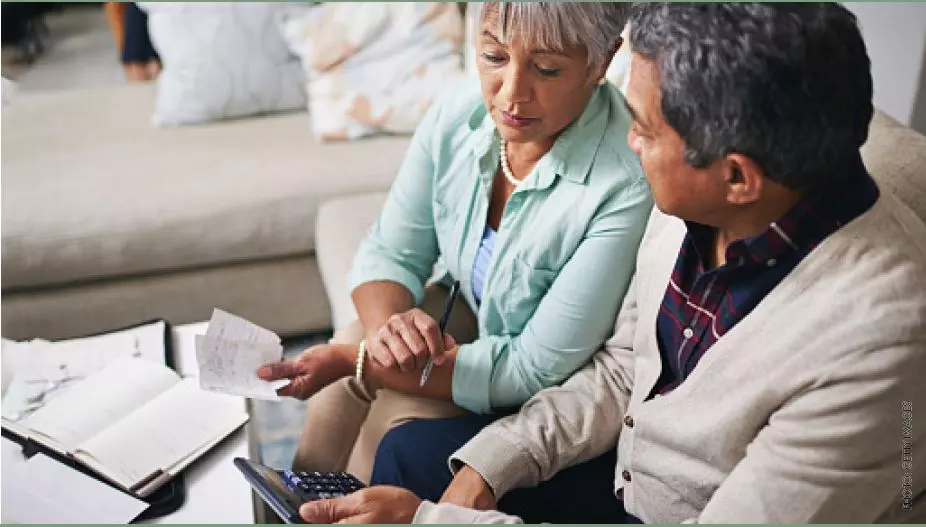Printable Version
Printable Version en Español

Be organized, proactive, and aware to protect yourself, family and friends from financial abuse
It’s easier than ever to handle our finances without setting foot inside a bank with so many advances in technology, but these changes have also made fraud and financial abuse a prevalent problem for older adults. Most elder financial abuse involves scams, forgery, identity theft, or undue pressure to give someone access to property or funds by simply providing information over the phone. Older adults are often targeted for such exploitation because they may be perceived as trusting, they may be cognitively impaired, they may have more funds available after a lifetime of saving, and potentially less exposure to technological advances.
Tips for Protecting Finances
Seniors can protect themselves from financial abuse by making sure financial records are organized and being aware of how much money is in all accounts. In addition, you can protect your assets by talking to someone at your bank, an attorney, or a financial advisor to discuss your options for ensuring your wishes for managing your money and property are followed in the event you become incapacitated. Other activities to help protect yourself include:
- Carefully choosing a trustworthy person to share your financial planning matters with so they can assist you with tracking your finances if you are unable to do so yourself.
- Locking up your checkbook, account statements, and other sensitive information.
- Ordering copies of your credit report to review for suspicious activity. (You are entitled to a free copy of your credit report from each of the three major credit bureaus once every twelve months. To order your free annual reports, go to AnnualCreditReport.com or call toll- free 1-877-322-8228.)
- Never providing personal information, including your Social Security number, account numbers, or other financial information to anyone over the phone unless you initiated the call.
- Asking for details in writing and getting a second opinion from a financial advisor or attorney before signing any document you don’t understand.
- Paying with checks and credit cards instead of cash to have records of transactions.
Tips for Family and Friends
Family and friends can also help by being aware of the many ways in which an older person may be financially exploited. There are many scams and frauds that attempt to get bank account information or Social Security numbers from the elderly to steal their identity or money. Be on the lookout for signs of possible financial abuse, including:
- Unexplained account withdrawals.
- Another individual unexpectedly making financial decisions on the older person’s behalf.
- Disappearance of funds or valuable possessions.
- Unanticipated transfer of assets to another individual.
- Sudden changes to a will or other important financial documents.
- Suspicious signatures on checks.
If you suspect elder financial abuse, talk to the victim to determine what is happening and who is involved. For instance, you’ll want to know whether a new person in their life is helping them manage their money or a relative is using their credit card without permission. If financial abuse seems likely, you may want to contact your state’s adult protective services and the local police for assistance.
You should also contact any bank or other financial institution involved to notify them of the potential abuse, and they may be able to assist you. They may not be able to provide you with specific information about accounts or transactions due to privacy laws, but they have the ability to review information for potential abuse as well as the resources to report abuse.
Also be aware of consumer financial protection regulations that help protect funds withdrawn from an account without authorization. For example, most cases of fraud and identity theft are committed using an access device, such as when an individual steals an older person’s debit card and pin number to withdraw money from a checking account.
The Electronic Fund Transfer Act, which is implemented through Regulation E, protects consumers from losses that may occur as a result of certain unauthorized electronic financial transactions, such as unauthorized ATM withdrawals and point-of-sale terminal transfers in stores. If a debit card or the card number is used to make an unauthorized withdrawal from a checking or savings account, you can minimize your losses by contacting your bank as soon as possible. Your maximum liability under Regulation E is $50 if you notify your bank within two business days after learning of the loss. Additionally, many credit card issuers have zero-liability policies, meaning that customers typically do not pay for unauthorized transactions, so contact your credit card issuer as soon as you discover any.
For more information on elder financial abuse, visit:
Protecting older adults from fraud and financial exploitation
For more help or information, go to FDIC.gov or call the FDIC toll-free at 1-877-ASK-FDIC (1-877-275-3342). Please send your story ideas or comments to ConsumerNews@fdic.gov
